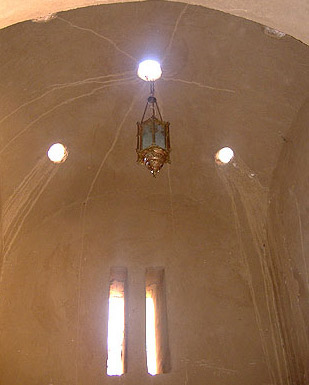\What every happened to New El-Gourna
by Jane Akshar

Notation: Jane Akshar, operates Flats in Luxor, a member of the AETBI, that offers flats for lease as well as local tours of the Luxor region. She also operates our Luxor News Blog.
Old Gourna is located on a hillside overlooking the West Bank at Luxor. It has always been of interest to tourists, and today many of its inhabitants rely upon shops built to cater to the tourist industry. Gourna doesnt translate well from Arabic so one will see spellings of Qurna, Gurna or Gourna, but they are all one and the same.

It will be difficult to look over to the West Bank at Luxor and not see the old village of Gourna, which is both a landmark on that side of the Nile, and to some, a rather mysterious place, full of intriguing histories of tomb robbers and rouges. Of course that was years ago, but the village does sit atop as many as one hundred tombs that need to be examined. Therefore, the residents of the old village are being moved to a new location at Al-Taref city on Luxor's outskirts., while Egyptologists anxiously await their chance to explore new territory, though there are likely to be no unopened tombs beneath the town.

This was not the first effort to move the villagers of El Gourna. Some 60 years ago, another was made to move the residents of Gourna to a new village designed by Hassan Fathy. Born in Alexandria in 1899 to an Egyptian father and a Turkish mother, he was an outstanding and innovative architect who demonstrated how elements from vernacular Arab urban architecture, such as the malkaf (wind catch), shukshaykha (lantern dome) and mashrabiya (wooden lattice screen), could be combined with the mud-brick construction traditionally practiced in Nubia in Upper Egypt to form a distinctive, environmentally and socially conscious building style that linked the use of appropriate technologies with co-operative construction techniques and the guiding thread of tradition. Born in Alexandria, he was responsible for some 105 projects in Egypt, Spain, Kuwait, Palestine, Greece, Saudi Arabia and the United States, among other locations.

Unfortunately, his New El Gourna project was doomed to failure. Much like today, the very people it was being built for did not want to move so no matter how wonderful the design it was never going to be a success. And yet it was a much better location than the village that the residents of old Gourna are being made to move into in 2006. Many of these people earned their living from the tourist trade, and the new location will take them away from the heart of that business. However, this time they will not be allowed to return to the old village. Indeed, the old village will probably not exist for very long.


The village designed by Hassan Fathy during the 1940s was situated on the main tourist road to the Valley of Kings and his idea was that the tourist coaches would come into the village and buy local crafts. He built the village following the traditions of the tribal families living in the old village on the hill and had workshops and souks planned. Frankly it would have been a much more interesting and pleasant place if it had worked. It is still there, and while taking a look at the newer village, I also decided to have a look at Hassan Fathy's village that was never put to use. The overall design is fantastic and I was particularly impressed by the mosque, which somehow reminded of the hypostyle hall at Karnak, having pillars and the same feeling of space. Within the housing, the rooms were amazingly cool and airy because of the use of the traditional materials and the domed design. But like the ancient monuments around Luxor, including some of the major temples, it is being attacked by the underground water. Few buildings have survived and many of the houses have been converted into concrete boxes.

Initially, we were shown around by the guardian of the mosque who took us into old houses, around the mosque, and handed us over to the guardians at the theatre and Hassan Fathy house. One of the houses that remains is occupied by the first family to leave Gourna. We were shown around by the house owner's daughter who is a tour guide and speaks excellent English. She showed us fireplaces, chimneys, pigeon roosts and even the original bed Hassan Fathy built for himself. We also went to the theatre, reminiscent of an Elizabethan stage. Every where there were traditional lamps, marhabeya screens, domes and coloured glass letting silvers of light through.
The village is well worth a visit when in Luxor. There is a sign for it about 20 meters from the main cross roads before one reaches the colossus of Memnon on the West Bank. With energy prices peaking and cookie cutter houses springing up everywhere in our modern world, its architecture is as relevant today as it was 60 years ago.

